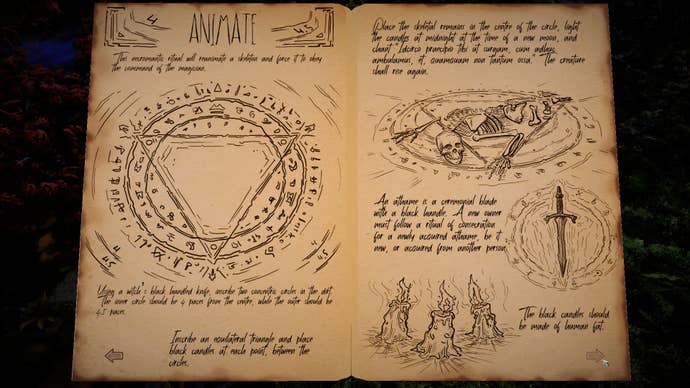I’ve only dipped my distal index fingerbone in The Necromancer’s Tale, a just-released historical fantasy tactics RPG from Psychic Software, but I can at least report back that the character creator is a gentle joy, to the point that I was disappointed to reach the end of it. True to the promise/threat of “400,000 words of hand-written narrative and lore”, it’s a hearty choose-your-own-adventure prologue that follows the protagonist’s infancy and early adulthood. Each choice you make skews the stats on the left. Might sound unremarkable of concept. Here’s why it’s stuck with me.
Watch on YouTube
Firstly, the guy doing the narration has a fine set of pipes indeed, with intonation that reminds me of certain elder Drag n’ Dunkers (the loudly painted 3D graphics, a little less so). I can imagine that actor leaning across the campfire to tell tales of the Time of Troubles, a chaotic period, when gods were made flesh and forced to walk the earth. In general, I wish more RPGs conducted themselves like weird storytellers in the woods. Make us feel like kids again, watching the flames on a frosty, moonless Halloween.
Secondly, it’s a nice showcase for the game’s writing, and how it informs the stat-massaging. The Necromancer’s Tale is set near Venice in a mildly sorcerous version of 18th century Europe, where “courtly intrigue collides with black magic even as chemistry emerges from alchemy”. You are a child of nobles who meets with strange fortune and takes a hard left into lichedom.
That’s the kind of rich setup that often leads to sentences that sag beneath the weight of adjectives and metaphors like sickly, fermenting, wasp-blighted plum trees, but the prologue writing is spare and evenly stressed, easy to read aloud. More importantly, the relationship between the choose-your-own adventure decisions and the evolution of your stats is unclear in an engaging way.
Some of the decisions are QTE fare, like “do I fend off this stone-throwing girl with a stick or do I ask her to stop”. Sometimes they are more introspective. An example: I have just been banished by my parents, for reasons unknown. As I’m borne away in a carriage, I have the choice of feeling angry and unwanted, or wounded and betrayed, or simply confused. Now, see if you can work out how those emotions will feed into my nine core stats: Strength, Agility, Constitution, Acuity, Knowledge, Investigate, Analyse, Impress, or Convince.
It’s not an absolute enigma, but there’s enough slipperiness that I make the choice more to discover the outcome, than to boost the preferred stat. I like it when RPG yarns successfully unhitch my brain from The Numbers. Elsewhere, the prologue attempts the perilous feat of taking some Numbers away. As you age, things happen that lower your stats. I found these misadventures just as convincing – all part of life’s pissy golden tapestry – and I liked how they got around the presumable underlying design issue of needing to cap the player’s points.

If all of this leaves you cold, rest assured that there’s the option of skipping the adventure book element and just adding or deducting those points from a bar. Go on, play it like you’re doing your taxes – I’d judge you for it if I hadn’t once been fined £800 for handing my tax return in late. You can also tinker with the points after completing the prologue. Myself, I’m sticking with the character I’ve rolled, an absolute weed with respectable detective skills, a little book learning and a plausible manner.
As for the rest of the game – well, it’s early days, but I’m not sure the combat is anything to write home about. It’s turn- and hex-based with melee, projectiles and spells. Pretty routine. My enthusiasm will hinge on whether the necromancy component lets you do things more devious than summoning increasingly gnarly hordes.
I’m more compelled by the game’s social intrigue aspect, which reminds me of Vampyr. The greater the quantity of skelliwags and other phantoms you hang out with, the more you risk getting into trouble with local townsfolk. There’s the risk of torchlit arrest, court proceedings and even a brusque lynching for necromancers who don’t keep their cadavers in check. The prologue gave me a little taste of this: an eventful meeting with Isaac Newton, who shrieked that I was an agent of the grim reaper before dropping peacefully dead of old age. You have to love the chutzpah of a game that relegates one of the Enlightenment’s big beasts to the role of Scream Queen.
I can’t promise that we’ll review The Necromancer’s Tale, because belts remain tight and I have yet to devise the enchantment that lets me conjure an army of skeletal staff writers. No, chatbots don’t count: that’s not “dark magic”, just tech industry chicanery, and you can tell Bezos I said so, assuming he is not you. Still, perhaps I’ll keep plugging away with this. There’s the prospect of escorting a corpse to a ball, amongst other things. If all of the above is quite enticement enough, you can learn more on Steam.







